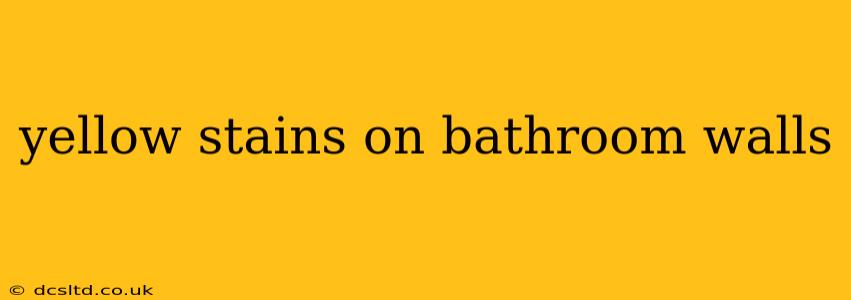Yellow stains on bathroom walls are a common and unsightly problem, often indicating underlying issues that need addressing. These stains can range from subtle discoloration to noticeable patches, significantly impacting the aesthetic appeal of your bathroom. This comprehensive guide will delve into the various causes of these stains, effective removal methods, and preventative measures to keep your bathroom walls looking their best.
What Causes Yellow Stains on Bathroom Walls?
Several factors can contribute to the appearance of yellow stains on your bathroom walls. Understanding the root cause is crucial for effective treatment and prevention.
1. Mold and Mildew:
This is the most frequent culprit. Mold and mildew thrive in damp environments, and bathrooms are particularly susceptible due to high humidity levels from showers and baths. These fungi release spores that can stain walls a yellowish-brown hue. Often, the stains are accompanied by a musty odor.
2. Hard Water Stains:
Hard water, rich in minerals like iron and calcium, can leave behind residue on walls, resulting in yellowish discoloration. This is often more noticeable around fixtures like showerheads and faucets where water splashes frequently. The stains are typically more subtle than mold stains but can build up over time.
3. Nicotine Residue:
If your bathroom is used by smokers, nicotine can accumulate on walls, leading to yellowing. This is more likely to occur in poorly ventilated bathrooms. Nicotine stains are notoriously difficult to remove.
4. Water Leaks:
Hidden leaks behind walls can cause significant damage and discoloration. The water can seep into the wall materials, encouraging mold growth and staining. Yellowing in this case might be accompanied by bubbling paint or wallpaper.
5. Age and Oxidation:
Over time, paint can yellow due to oxidation and exposure to sunlight and humidity. This is a gradual process, and the yellowing is usually uniform rather than appearing in patches.
How to Remove Yellow Stains on Bathroom Walls?
The best method for stain removal depends on the underlying cause.
1. Removing Mold and Mildew Stains:
For minor stains: A solution of bleach and water (1:10 ratio) can be effective. Apply the solution using a spray bottle, let it sit for a few minutes, then scrub gently with a brush. Rinse thoroughly and allow the area to dry completely. Always wear protective gloves and eye protection when working with bleach.
For severe stains: A stronger solution or a commercial mold and mildew cleaner may be necessary. Follow the product instructions carefully. In some cases, professional help might be needed to address extensive mold infestations.
2. Removing Hard Water Stains:
A solution of white vinegar and water (equal parts) can often dissolve hard water deposits. Apply, let it sit, then scrub and rinse thoroughly. Commercial hard water stain removers are also available.
3. Removing Nicotine Stains:
Nicotine stains are notoriously stubborn. Try a solution of trisodium phosphate (TSP) and water, following the product instructions carefully. This is a powerful cleaner, so ventilation is crucial. Again, professional cleaning might be necessary for severe staining.
4. Addressing Water Leaks:
If a leak is suspected, identify and repair the source immediately to prevent further damage. This may require professional plumbing assistance. Once the leak is fixed, the affected area needs to be dried thoroughly, and any damaged materials replaced before repainting or repapering.
5. Dealing with Age and Oxidation:
If the yellowing is due to age and oxidation, repainting the walls is the most effective solution. Choose a high-quality paint designed for bathrooms to withstand humidity.
How to Prevent Yellow Stains on Bathroom Walls?
Prevention is key to maintaining clean and stain-free bathroom walls.
1. Ensure Proper Ventilation:
Use an exhaust fan during and after showers to remove excess moisture. Open windows whenever possible to improve air circulation.
2. Regular Cleaning:
Regularly clean your bathroom walls with a mild detergent and water to prevent the buildup of dirt and grime.
3. Promptly Address Leaks:
Repair any leaks immediately to prevent water damage and mold growth.
4. Choose Moisture-Resistant Paint:
When repainting, use a paint specifically formulated for bathrooms to resist moisture and mold.
5. Consider Waterproofing:
For areas particularly prone to moisture, consider applying a waterproof sealant to protect the wall surface.
By understanding the causes of yellow stains and implementing appropriate removal and preventative measures, you can keep your bathroom walls clean, fresh, and aesthetically pleasing. Remember, if you are unsure about tackling the stains yourself, it's always best to seek professional help.
